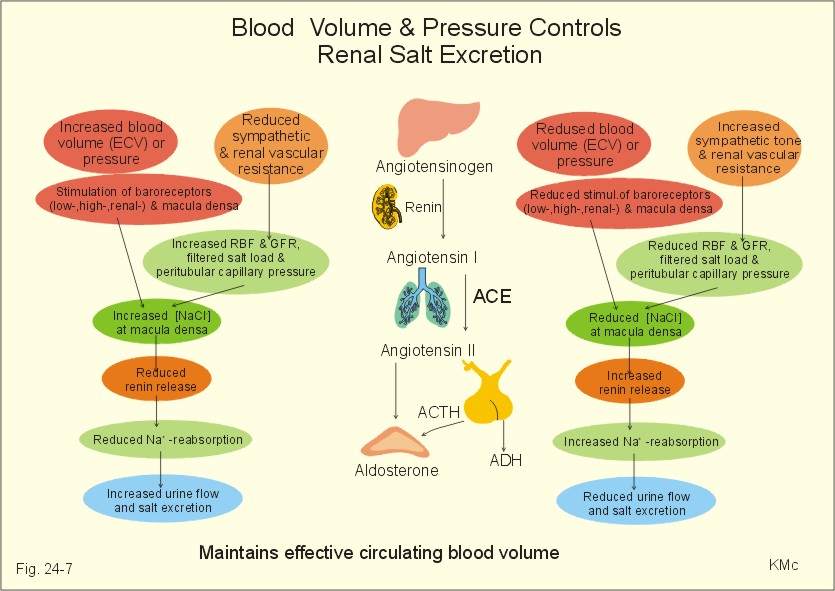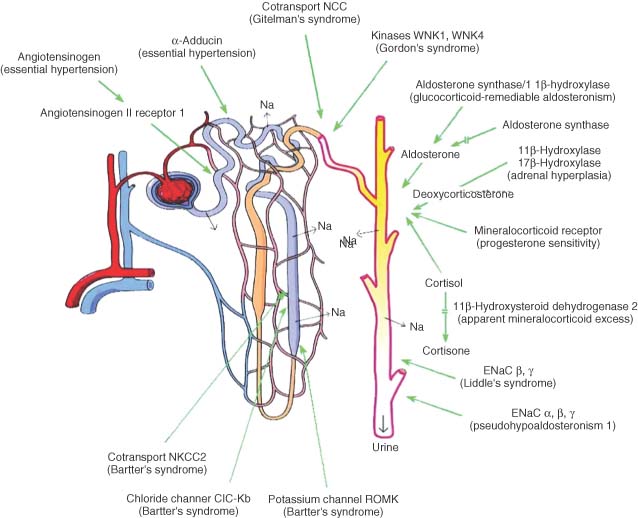Sodium is an essential nutrient for all living organisms.
It is supplied from the diet as salt, Sodium Chloride.
It regulates blood volume, blood pressure, osmotic equilibrium and pH.
The renin-angiotensin system and the atrial natriuretic peptide regulate the amount of fluid in the body. Reduction of blood pressure and sodium concentration in the kidney result in the production of renin, which in turn produces aldosterone, retaining sodium in the urine. Because of this, the osmotic pressure changes and osmoregulation systems generate the antidiuretic hormone, causing the body to retain water and restore its total amount of fluid. Receptors in the heart and blood vessels sense the resulting distension and pressure, leading to production of the atrial natriuretic peptide, causing the body to lose sodium in the urine; the osmoregulation systems detect this and remove water, restoring the total fluid levels.
Sodium is also important in neuron function and osmoregulation between cells and the extracellular fluid; their distribution is mediated in all animals by Na+/K+-ATPase. Hence, sodium is the most prominent cation in extracellular fluid: the 15 liters of it in a 70 kg human have around 50 grams of sodium, 90% of the body's total sodium content.
In C4 plants, sodium is a micronutrient that aids in metabolism, specifically in regeneration of phosphoenolpyruvate and synthesis of chlorophyll. In others, it substitutes for potassium in several roles, such as maintaining turgor pressure and aiding in the opening and closing of stomata. Excess sodium in the soil limits the uptake of water due to decreased water potential, which may result in wilting; similar concentrations in the cytoplasm can lead to enzyme inhibition, which in turn causes necrosis and chlorosis. To avoid these problems, plants developed mechanisms that limit sodium uptake by roots, store them in cell vacuoles, and control them over long distances; excess sodium may also be stored in old plant tissue, limiting the damage to new growth.






!!
from the diet to the blood
from extracellular fluid to the cytoplasm
Sodium extrusion from the cell
Na/K-ATPase as signal transducer 2003
Na\K ATPase
Platelet Ca2 plus handling in essential hypertension : role of a plasma ouabain-like factor. 1999
Sodium driven transporter
Glucose, Aminoacids


Hypoglycemia in Type 1 Diabetes, 2010
Glucose, Aminoacids
Iodine
NIS

New Human Physiolog
Sodium renal handling
Sodium reabsorption take place mainly by two mechanisms:


Kidney modeling and systems physiology, 2009

Chloride channels as drug targets, 2009


Regulation of ENaC-Mediated Sodium Reabsorption by Peroxisome Proliferator-Activated Receptors, 2010

Renal Physiology: Reabsorption and Secretion
Uric acid
GoutPal

Hypothyroidism
Tubular failure ??
Antiviral Drug-Induced Nephrotoxicity, 2005
Fractional excretion of Na+ (5x) and of K+ (2x) increases during training, leading to a net loss of both ions.

Alterations of Fluid and Electrolyte Balance in Thoroughbred Racehorses Following Strenuous Exercise During Training 1991
 serum sodium strenuous
serum sodium strenuous
SGLT1 AMPK
phenformin increases SGLT1